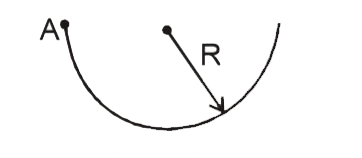A thin rod of length and mass is bent at its midpoint into two halves so that the angle between them is . The moment of inertia of the bent rod about an axis passing through the bending point and perpendicular to the plane defined by the two halves of the rod is.
The correct Answer is:b
To find the moment of inertia of the bent rod about an axis passing through the bending point and perpendicular to the plane defined by the two halves of the rod, we can follow these steps:
Step 1: Understand the Configuration
The rod of length L and mass M is bent at its midpoint, forming two halves that create a 90∘ angle. Each half of the rod will have a length of L2 and a mass of M2.
Step 2: Moment of Inertia of Each Half
The moment of inertia I of a thin rod about an axis through one end and perpendicular to its length is given by the formula:
I=13ml2
For each half of the rod:
- Mass m=M2
- Length l=L2
Substituting these values into the formula gives:
Ihalf=13(M2)(L2)2=13(M2)(L24)=ML224
Step 3: Total Moment of Inertia
Since there are two halves of the rod, and they are both contributing to the total moment of inertia about the bending point, we need to add the moments of inertia of both halves:
Itotal=Ihalf+Ihalf=ML224+ML224=2ML224=ML212
Final Answer
Thus, the moment of inertia of the bent rod about the axis passing through the bending point and perpendicular to the plane defined by the two halves is:
I=ML212
The rod of length L and mass M is bent at its midpoint, forming two halves that create a 90∘ angle. Each half of the rod will have a length of L2 and a mass of M2.
The moment of inertia I of a thin rod about an axis through one end and perpendicular to its length is given by the formula:
I=13ml2
For each half of the rod:
- Mass m=M2
- Length l=L2
Ihalf=13(M2)(L2)2=13(M2)(L24)=ML224
Since there are two halves of the rod, and they are both contributing to the total moment of inertia about the bending point, we need to add the moments of inertia of both halves:
Itotal=Ihalf+Ihalf=ML224+ML224=2ML224=ML212
Thus, the moment of inertia of the bent rod about the axis passing through the bending point and perpendicular to the plane defined by the two halves is:
I=ML212
Similar Questions
A thin rod of length L of mass M is bent at the middle point O at an angle of 60∘. The moment of inertia of the rod about an axis passing through O and perpendicular to the plane of the rod will be

View SolutionA uniform rod of mass m is bent into the form of a semicircle of radius R. The moment of inertia of the rod about an axis passing through A and perpendicular to the plane of the paper is

View SolutionA uniform rod of mass m is bent into the form of a semicircle of radius R. The moment of inertia of the rod about an axis passing through A and perpendicular to the plane of the paper is

View SolutionA thin rod of length 4l, mass 4 m is bent at the point as shown in the figure. What is the moment of inertia of the rod about the axis passing through O and perpendicular to the plane of the paper?

View Solution
A thin rod of length 4l, mass 4 m is bent at the point as shown in the figure. What is the moment of inertia of the rod about the axis passing through O and perpendicular to the plane of the paper?
View SolutionA uniform rod of mass 2M is bent into four adjacent semicircles each of radius r, all lying in the same plane. The moment of inertia of the bent rod about an axis through one end A and perpendicular to plane of rod is

View SolutionTwo rods each of mass m and length 1 are joined at the centre to form a cross. The moment of inertia of this cross about an axis passing through the common centre of the rods and perpendicular to the plane formed by them, is :
View SolutionMoment of inertia of a thin rod of mass m and length l about an axis passing through a point l/4 from one end and perpendicular to the rod is
View SolutionTwo identical rods each of mass M and length L are kept according to figure. Find the moment of inertia of rods about an axis passing through O and perpendicular to the plane of rods.

View SolutionMoment of inertia of a uniform rod of length L and mass M, about an axis passing through L/4 from one end and perpendicular to its length is
View Solution
